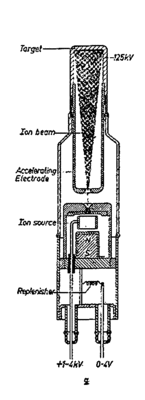I bet I would love working for them, if I could get into the habit of working again in a "real job". I've been freelance since about the middle '70's. Moved it from Washington DC to here when my jazz band toured here and we all said -- what in heck are we doing living in DC when there's Floyd? Both nicer people and well, you've seen what the area looks like.
I think I didn't phrase my question right, as I think this can work. Let's suppose I want to use a crummy ion source -- in this case because it's going to have to float off ground some +60kv or so -- don't want to mess with running my good mostly-monatomic microwave ECR source up there (which would require an isolation transformer of 100w+ good for 60kv isolation -- and it's too large anyway). So I would use a penning-type source, or even an E beam one, which makes mostly diatomic D ions. I don't need that much current in the resulting beam, but I do only want D+ out of this, not that and D2+ -- to a first approximation.
One has mass 2, the other 4 (a two to one ratio). To get them to a speed where you can separate them decently you first accelerate them to say, 1000v, then put them through a magnetic separator,
then do the main acceleration from +60 or so kV to -60kv or so. This is a reasonable supposition because it is something I plan to do. I only need ~microamp currents of D+ for this, but don't want the have to put in the power to accelerate the 90%+ of D2+ ions, or take that heat on my target, that your usual crummy ion source produces. Would that not be a workable plan? It adds some mechanical complexity to be sure, but that seems manageable. I know the "filtering" wouldn't get to the "purity" many other applications need -- but I don't need it perfect here -- just decent.
So I would need to select a 2::1 mass difference -- seems pretty easy, with ions at 1kv energy so the energy spread isn't that huge (maybe ~100v or 10% of the beam energy). Since I'm just designing this, I can make that 1kv some other number to get reduced percentage beam energy spread if required. And if I lose some of the desired ones, again, that's not a big deal in the design.
What I'm planning is a sort of beam on target device, with split supplies for the main acceleration, and an ion/pre acceleration source running off small batteries floating up at +60kv or thereabouts. If a few of the wrong kind of ions leak through -- it's not a really big deal, that first "9" of "purity" I get makes it good enough for this and a second 9 fantastic -- just saves a ton of wasted energy in the main acceleration, and a lot of needless damage to the target, which in this case might be a D compound (see my smart-target theorizing elsewhere
here) that won't take much heat without decomposing (which itself would be off ground at -60 kV so it's hard to keep cool easily with other than forced air or convection in oil).
I did see your formula, and thank you for one in human-usable units

-- it implies I think that I could pull this off, and not even need a big magnet to do it -- a small permanent magnet would get me there. I have a decent hall-effect magnetometer to tweak designs with for that. I've found that necessary as many PM makers are a bit, errrrrm optimistic about their magnet specs and calculations of reluctance in the pole pieces can be a bit off depending on dumb things like exact shapes and the iron alloy. At any rate, I wouldn't need the big voltages to concept-test this in a prototype.

- old borehole tube design from Phillips
In other words, this design more or less with a mass selection before the main acceleration gap. Most of the rest is already built.
Posting as just me, not as the forum owner. Everything I say is "in my opinion" and YMMV -- which should go for everyone without saying.